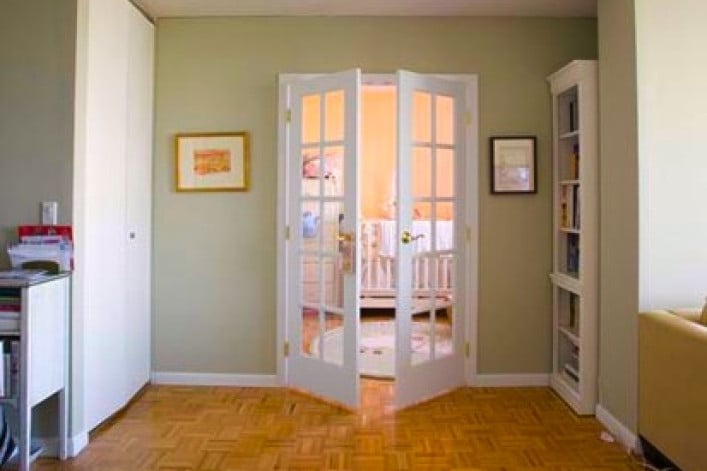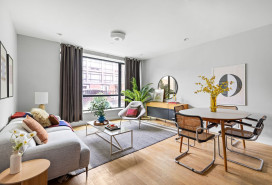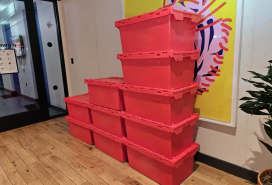From 1 room to 2: The insider's guide to temporary walls

Temporary walls are so New York. Just mention plans to build a non-permanent wall to non-New Yorkers and you’ll get some seriously quizzical looks.
In recent years though, the city's Buildings Department (and consequently, building management companies) has gotten stricter about ensuring that temporary walls--non-load-bearing pressurized walls that are not attached to a permanent wall or floor, and can be removed (relatively) easily, without damaging the permanent wall---are up to code.
While it's always been illegal to build a wall without a Department of Buildings permit, buildings tended to look the other way as multiple roommates shoehorned their way into apartments unaffordable on just one or two paychecks.
Some still look the other way and others flat out prohibit them. Meanwhile, temporary wall companies are working with management companies and customers to find solutions that won't violate building codes, but will still be cost-effective and efficient, considering that walls are often built for rentals.
Need help finding a rental that allows temporary walls? The rental experts at Triplemint, a Brick Underground partner, know exactly where to look. If you sign up here, you can also take advantage of Triplemint's corporate relocation rate--where you'll pay a broker's fee of 10 percent of a year's rent on open listings instead of the usual 12 to 15 percent. Bonus: The agents at Triplemint are a delight to deal with.
Options are often being limited to partial walls (that stop at least one foot from the ceiling) and bookshelf walls (see '9 Bookshelf Walls You Can Live With') which are considered furniture.
Communication with the temporary wall company and building management is important in order to avoid code-related problems (and the possibility of, say, the super or the fire department showing up one day to rip your wall out).
Expect to pay around $1,000 (including security deposit, which you should get back). But additions like windows, light panels can move that price up significantly.
Here are some other things to know before you take the plunge:
- Don't rely on your broker's word Make sure you ask management (not just a broker) whether you can erect a wall before you pay for anything, and before you sign your lease, to avoid disappointment. Your building may even specify which temporary wall company you can use.
- You’ll need a window. By law, in order for a room to be habitable, it must have a window. Make sure that wherever you’re going to build a wall, a window will remain in each room.
- The new rooms can’t be too small. According to NYC law, in order for a room to be classified as a bedroom it must be at least 80 square feet.
- Don't block exit routes. Temporary walls cannot block exit routes or interfere with the ventilation and sprinkler systems in apartments. They don't usually have locks in order to minimize danger of blocking exit routes during a fire.
- Consider French doors/sliding doors. If you’re worried about blocking off light (as this writer was when she had a wall built to make an extra room for baby), consider the more expensive options of French doors or sliding doors (which usually run between $1,000 and $2,000). They allow the light in and help make the space feel more open.
- Get it all in writing. Some companies get a bad rap on sites like Yelp.com for charging people to take their walls down. While none of the companies we spoke to admitted that they do that, be sure you have receive and sign documentation clearly stating that you won’t need to pay the company to take the wall down and you will get your deposit back as long as things are in good shape.
- Seamless vs walls with seams: Prefabricated walls with seams usually take less time to put up and are cheaper to build (they're also way more popular in NYC). They tend to look more temporary, which sometimes, in the eyes of building management, is a good thing. Seamless walls blend in better with your ceiling and wall and look more permanent, but they may require a touch-up paint job after the installation to make sure they blend in well with the ceiling or wall.
- Renting vs. buying the wall. Most companies lease walls to customers. The standard time-frame is up to three years, at which point a renewal fee is required. If you're thinking about using the wall for longer than three years, it may be worth it to purchase the wall if possible.
Here are four companies that specialize in building walls around the city. They all work with renters and owners.
1. The Living Space Company (www.livingspaceinc.com/)
Many New York City apartment buildings (including my own) require tenants to use The Living Space company because of their solid reputation. When I hired them two years ago, I found the experience pretty smooth. I gave them a $200 deposit, and $1,500 and 6 hours of work later, we had a two-bedroom apartment (with French doors!).
As long as we give them four weeks notice to take the wall down, there's no take-down fee, and we'll get our $200 deposit back as long as we don't go over a three-year rental period. The lease term is good up to three years, after that we can pay $237 plus tax for another three years (the company will go in, inspect and tighten the wall at that point to make sure it's safe for another three years).
The company does partitions with light panels, through window sills and more.
2. Room Dividers NY (www.roomdividersny.com/)
This Brooklyn-based company offers walls from $550-$3,500, though the average wall (built with a door) runs around $850 ($550 would be for covering up a doorway, $3,500 might be for a heavy duty sound-proof accordian wall).
Room Dividers rents the wall to customers, and they usually do leases up to three years. After that, you can extend the lease for $150, which covers them up to 3 years again.
It usually takes somewhere between 4-6 hours to build. There’s no need for a deposit, and the company says there are no fees to take the wall down.
3. Manhattan Pressurized Walls (www.mpwnyc.com/)
This company was named Best Pressure-Wall Builder by New York Magazine in 2011 . Seamless, sound-reduced temporary walls are built on the premises, in a process that usually takes about 5 hours.
The costs range from $800-$1,000 for a standard wall with door, but according to company president Simon Kaljevi, “the possibilities are endless.” The company has converted lobbies for construction, and worked on projects that cost up to $20,000.
As long as you give three weeks notice, there’s no additional cost to take a wall down, Kaljevi said.
Walls can be bought too, with purchase prices starting at $250.
4. All Week Walls (www.allweekwalls.com)
All Week Walls' temporary walls cost between $700 and $2,000. The company builds both seamless walls and walls with seams, though they prefer to go with seams, since they're more efficient and cheaper for the client.
Customers actually purchase the walls, and as long as they have four weeks notice, the company will take down the wall for free. Otherwise, it's somewhere around $350.
Donny of All Week Walls says he always complies with building management rules, building partial walls in some cases. Still, most clients opt for full-length pressurized walls, he says.
Related posts:
9 bookshelf walls you can live with
BrickUnderground's 6-step guide to renting a NYC apartment with roommates
Moving to NYC? Here’s a crash course in finding an apartment here

























